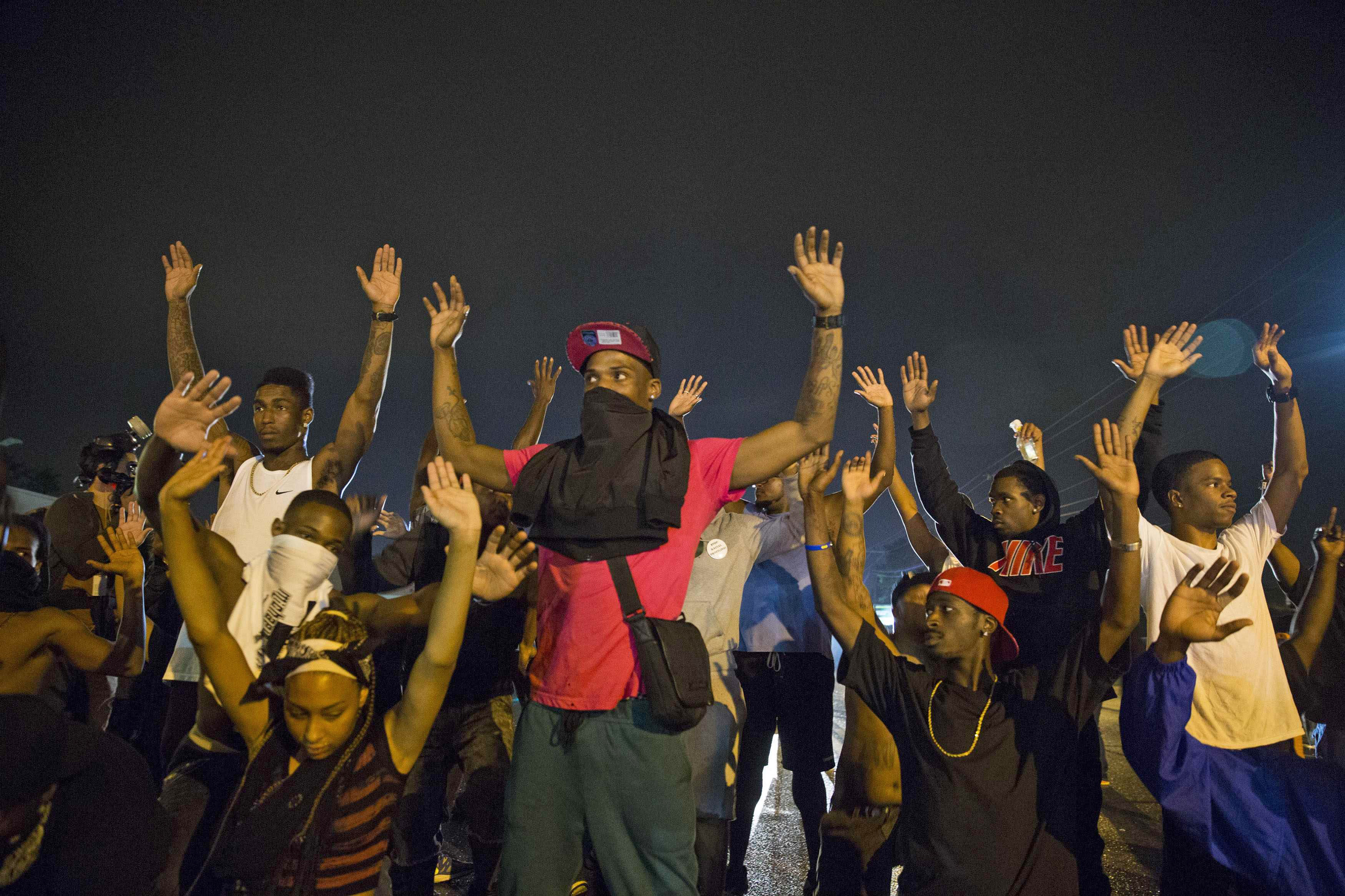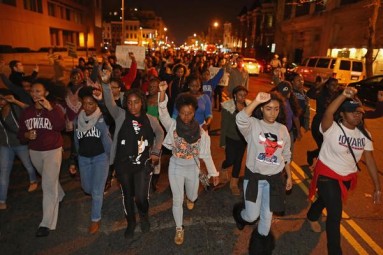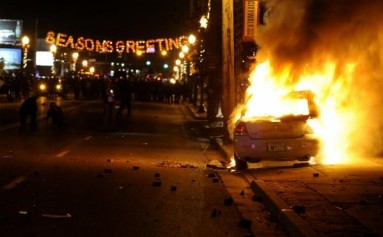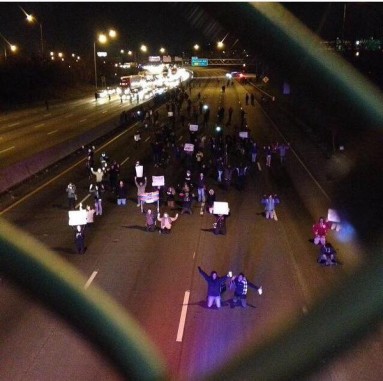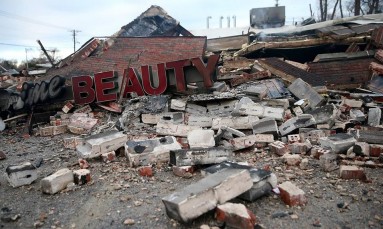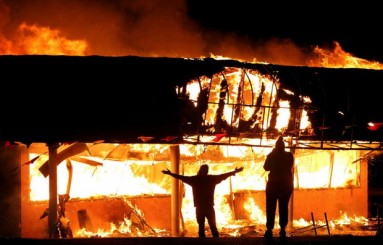As protests and riots spread across the country, so too poems, stories, quotes and pieces of theory from previous struggles circulate to describe the present moment. We've collected some of these fragments together. Justice for Mike Brown!
Resistance is a natural response to oppression and the story of people of African descent in the western hemisphere is one of rebellion and broken shackles.
Women and men marching on: these rag tag armies of black, brown and yellow soldiers armed with farm tools, the occasional musket and a plan to kill the slave master. Rising up out of their bondage, the rebels intended to be free in this world, or the next. Get free, or die trying.
Charles Deslondes. Makandal. Nat Turner. These names would produce a fear so strong in whites that the thought of an armed and angry black man would echo that fear for generations to com.
-Marshall "Eddie" Conway, Marshall Law
For me, I found that from my experience in the [Black] Panther Party, that counter-intelligence program, federal government, local police departments, politicians: they do what they supposed to do in terms of maintaining this system of oppression on the back of the Turtle. But we, as people who are trying to resist, sometimes don’t realize how we harm each other when we are not conscious of our own sexisms, our own ageisms, ableisms, our own inferiority complex, or how we act out, you know, especially men, how we act out of our own sense of male supremacy and hurt others. So the caring part means that we have to really look at how we treat each other. The loving part means that we have to see how we treat each other, because it means that we gonna create this new society right out of what we are doing to each other, or trying to do better in terms of how we wanna be loving to each other, we wanna be caring to each other…that part, we can’t minimize, we can’t say that ‘Oh, we’ll change after the victory.’ The victory is really how much we can accomplish as we struggle in changing our own social relationships.
-Ashanti Alston, Ferguson: Chronicle of An Insurrection
-Amiri Baraka, Monday in B-Flat
Revolutionaries know the system is fundamentally rotten. We believe that millions of people overthrowing capitalism and the government is the only way to stop police killings for good, and make a better life for all. Revolution means more than just putting a new president in office, or firing the worst cops. It means making a new kind of society, where everyone participates directly in running society. It means abolishing bosses, landlords and the police, and providing the means for a good life to everyone FOR FREE. It means ending racism, heteropatriarchy, and more. It means all human beings...relating to each other in a new and better way.
-East Coast Renegades, The Flatbush Rebellion
If you stick a knife in my back 9 inches and pull it out 6 inches, there's no progress. You pull it all the way out that's not progress. The progress is healing the wound that the blow made. And they haven't even begun to pull the knife out, much less heal the wound. They won't even admit the knife is there!
-Malcolm X
Until the killing of black men, black mothers' sons, becomes as important to the rest of the country as the killing of a white mother's son, we who believe in freedom cannot rest.
-Ella Baker
AGAINST THE POLICE
My entire Oeuvre is against the police
If I write a Love poem it’s against the police
And if I sing the nakedness of bodies I sing against the police
And if I make this Earth a metaphor I make a metaphor against the police
If I speak wildly in my poems I speak against the police
And if I manage to create a poem it’s against the police
I haven’t written a single word, a verse, a stanza that isn’t against the police
All my prose is against the police
My entire Oeuvre
Including this poem
My whole Oeuvre
Is against the police.
-Miguel James
***: It does feel like its easier for people who weren’t there to see the more spectacular things – the looting, the arsons, the Molotov cocktails – but unfortunately the efforts to create space without police is harder for people to see from afar. It seems obvious that this was really central to the ferocity of what was happening. What did it feel like to be at the [QuikTrip]? What was that space like? Also what were some of the more specific ways that people prevented the police from coming there or other areas that had been carved out?
+++: Well for the most part the QT was this incredibly festive and joyful place in the daytime where people were doing graffiti, driving up with giant barbeques and giving away hundreds of hot dogs; everyone brought water to share, nothing cost money, everything was free. It became a weird cultural center as well. There were rappers, people break dancing, a teenage step-crew came in. There was a joyful street fair atmosphere at times. At the same time people would be handing out masks for the night, sharing stories from the nights before. At one point I hung out with a man who shared pictures of all the shoes he’d looted the night before and we traded stories. People were talking about what to do if they gas this way, what to do if they come from that way. So while it was this festive and celebratory atmosphere it was clearly also a space where people were forming strategies and talking and connecting. Since it was the central gathering point, everyday you’d come back and you’d start to see people and recognize faces; maybe you’d have talked to someone the night before or you’d engaged in something with them and you’d be able to see them again and talk; you’d begin to form relationships and share ideas. That was really exciting.
Toward the night the police would eventually push towards the QT, but the QT itself was about half a mile from where most of the conflicts happened, so often they’d only be able to reach it after hours and hours of street fighting. It took them so long because they were terrified of coming into the crowd, especially during the day when there would be thousands of people around. The St. Louis area has a history of police being shot at, and police are very aware of that. The police know people are armed and willing to shoot. From the beginning of the uprising, rebels made this very clear: one of the first things to happen after they killed Mike Brown was shots being fired into the air. And then Sunday, the first night of rioting, during the looting, people were again firing shots. I can think of one particular situation where the police tried to push in, and people formed a line to fight them off. As the standoff was ending, the police cowardly gassed the crowd and left. Instantly there were gunshots at the police all up and down that mile stretch of road. You could hear gunshots everywhere, and see people jumping out of cars to shoot; shooting at them, shooting in their general direction. People learned that you didn’t even need to shoot at them, but simply shooting in their general direction or making it known that you were armed was enough to keep the police back. So the guns kept them at bay. It was the first time in my life that I’ve ever seen that level of blatant armed action in a riot or demonstration or whatever you want to call what was going on up there.
Secondly, the other thing that I’d never seen before, specific to this situation was the car culture and the way cars were used in a few ways to confuse the police, block them and also just tie them up. West Florissant, the major street where all the rioting and looting and fighting was happening, is a four lane highway. And so up and down the strip people were using it as a cruising ground with countless cars packed with people, blaring music, with half a dozen kids on the hood, honking horns, and everyone screaming. This created a situation where it was impossible for the police to drive into the crowd; the cars were so dense. And also the general noise added to the insanity of the situation, so it was totally nuts to be out there. It was a situation that was completely uncontrollable and they had no idea what to do. If they came in on foot, they were attacked; if they came in cars, the cars would get stuck and they were attacked. Also a lot of the guns were kept in peoples’ cars, so people were mobile and armed. At times cars were also weapons. On one night cars actually crashed into police lines. People would use the cars as barricades; everyone would drive and park their cars across the street and form lines behind them. I remember at one point two young girls parked their cars hood to hood blocking all four lanes of traffic and on the other side of the cars, facing the police, everyone had guns. The cars were used as barricades to shoot from, as a means to stay mobile, as celebratory parade vehicles, and in general a way to confuse and intimidate the police. So I really think these two things particular to Ferguson, the gun culture and the car culture, helped to create and keep this autonomous police-free zone. Not to mention the fact that there were thousands of people participating."
-Conversation between *** and +++, Guns, Cars, Autonomy
